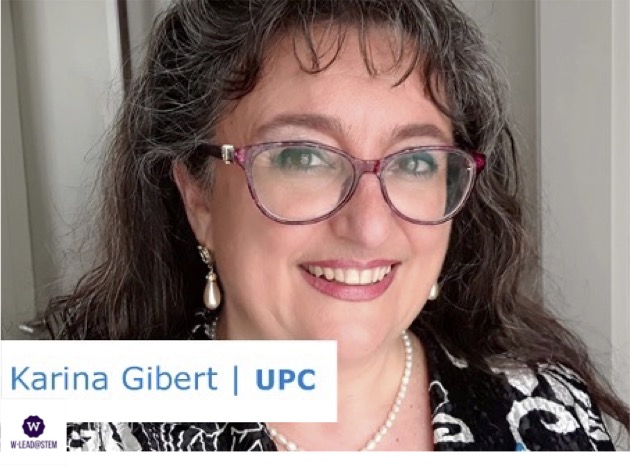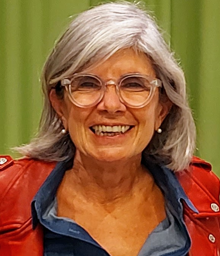This page is a working page with elements discussed in the W-STEM special session at the conference AICCSA 20201. Join us on Slack Zoom 1st December, 2021, 11:00 - 12:00 Paris Time [slideshare id=250764746&doc=aiccsa-2021-w-stem-211201171357]
The Women in Computer Science & STEM session highlights concrete opportunities females have to carry on successful careers in Computer Science and STEM in general. The aim is to bring together junior, and senior women computer scientists/STEM, encourage collaboration through formal and informal discussion and provide a perfect opportunity for young researchers to discuss their research and get valuable feedback in an open and friendly environment. Besides, this event promotes networking opportunities and a support network comprising role models, mentors, and peers. The event is devoted to all scientists – male & female – it includes talks by distinguished women speakers from industry and academia who will share their experiences with the participants. With young computer science engineers working in the industry, senior speakers will share a panel to exchange their experiences and vision of their professional careers and promote an inclusive and diverse community.
Diversity & Inclusion from a female perspective: hope, bias and politically incorrect questions
Panel Teasing Questions
The following twelve teasing questions are intended to guide your 5-10 minutes panel statement. Of course, according to your points of view, you can address other issues you want to bring into the discussion. The questions have been organised according to three topics:
- Inclusive language and D&I friendly communication
- New STEM Challenge: Ageisms
- Prejudice of Childfree Women in STEM
After your 5-10 minutes panel intervention, we will open the floor to discussion among panellists and the audience. The panel chairperson will bring other “surprise” questions, and you can also propose other questions.
Inclusive language and D&I friendly communication
“Inclusive language is not intended to deface the language.”
Definition: Using inclusive language is a way of showing consideration for everyone we meet. It is a way of recognising, accepting, and sometimes celebrating personal characteristics such as gender, race, nationality, ethnicity, religion, or other attributes that make up a person’s identity.
- Describing communities in intention or extension
According to linguistic relativism, “we are what we have been told. This view can both elevate and confine us up at the same time“. If you use only two words to describe all the colours around you, you start to see the world in two colours.
S.SANDRINE ZUFFERE and PASCAL GYGAX, Comment le langage brouille nos représentations du genre, Le Temps, Lundi 16 août 2021.
Q1. This statement shows how important it can be that women are represented in all the disciplines in STEM and all positions. In the academic world, should we learn and teach how to use and develop inclusive language? Should we promote and encourage this practice? How? Which would be encouraging friendly incentives? Should there be corrective actions?
- Which properties and adjectives for describing women, men and all?
Language gives us a limited number of options for talking about an unlimited world. Secondly, it draws our attention to properties of the world that are not always the most relevant. At the moment in which our parents, families and surroundings begin to make predictions about our identity, starting with our sex: girl or boy? On our physical appearance: Who will she or he look like? About our personality: what will be her/his character? Yes, a baby arrives naked on earth but already with many identities determined by its environment. How much freedom do we have to be ourselves?
Q2. How do we, as a scientific community, characterise, picture and refer to female professionals? Do we represent them in our language (oral/written) in the images we use in our communications? Do we think of a woman when we refer to a dean, a lab director, a mentor, an assistant, a professor, university president? Which adjectives do we use when referring and addressing colleagues or students? Do we opt for generic pronouns, or do we insist on naming “communities” (i.e., men and women and others to be inclusive)? Do we pay attention, or are we so tired that we do not change our language? Is this, in the end, important to us?
New STEM Challenge: Ageism
“Age discrimination involves treating an applicant or employee less favourably because of his or her age. … It is not illegal for an employer or other covered entity to favour an older worker over a younger one, even if both workers are age 40 or older.” An employer can for example favour a man of any age over a woman for “secret fear” of a potential pregnancy but not considering potential fatherhood as being a drawback.
- Image and age in academia: how is female scientists’ image perceived and judged?
For my friends in their 50’s, “I don’t know how much time you have left, so I’ll keep this brief. Happy Birthday.”
Q3. Women in patriarchal societies and communities have to deal with their image. The importance attached to one image and its dress code differs across disciplines and gender. For women, the image and dress code often deserve more attention than for men. Of course, scientific sub-communities are not excluded. How would you describe your experience regarding your image? Do you make decisions about the dressing code? Do you associate it with professional credibility and all the prejudices related to women, e.g., beauty and fashionista vs intelligent, serious, professional, colour code, makeup or not?
- Growing or getting “old”
Q4. Have you ever thought about your age as a tool for promoting or demeaning your career?
“Gendered ageism and grey hair: must older women choose between feeling “authentic” and looking competent?”
“Grey hair on a woman … produce[s] one of the least desirable personas in Western society – an old woman”. Women employed other beauty practices to mitigate the effects of grey hair, indicating a conflict between a (subjectively) authentic appearance and societal perceptions of competence. (Symonds & Holland, 2008)
Q5. In your opinion, the colour of the hair, physical appearance, and esthetical procedures perceived by patriarchal codes to “lack of authenticity”? What look and remarks from colleagues do a woman director receive when she is devoted to working and does not give importance to her image (e.g. colouring hair, having her hair done, paying attention to her weight)? Do men receive the same remarks? Is this thought a patriarchal bias too, or a socio-economical bias or both? How can we fight against these preconceived aspects? Can they skin your career or the perception of your colleagues regarding your professional reputation? Can image open/close opportunity doors?
- Have you thought about whitewashing your résumé?
At my age, it’s time to fight everyday ageism — especially when I’m guilty of it.
“I tried to whitewash my résumé — and thereby my age — by lopping off early jobs and erasing the year I graduated from college and grad school.”
Q6. In disciplines like ours, where being trendy, cool, dynamic, open-minded, connected, etc., are positive and empowering characteristics, dismissive quips about older people can come up very quickly. It can be devastating when interacting with students at young ages, for example. Prejudices prevail, for instance, not properly using a smartphone or social media, jokes about us losing our memory or hearing, and the proliferation of “anti-ageing” messages in advertising are issues related to our “image” as seen by others.
What do you think about this ageism? How can these biases be erased? Is this important? Do you feel these ageism prejudices harm the last or two miles of your academic career as female professionals?
Prejudice of Childfree Women vs Mother/parenthood in STEM
Definition: The term childless describes a group of women who are not mothers but for whom the reasons are either mixed or unidentified (Houseknecht, 1987). Childfree women, on the other hand, have made a deliberate decision not to be a mother and are specifically defined as “…those who expect to have no children in their lifetimes, and are either fecund (physically able to have a birth) or are surgically sterile for contraceptive reasons” (italics appear in the original quote; Martinez, Daniels, & Chandra, 2012, p. 4). Finally, involuntarily childless women may wish to be mothers but are not due to unavoidable obstacles (e.g., difficulty conceiving, lack of a partner, financial limitations; Jeffries & Konnert, 2002). (The Justification of Prejudice Toward Childfree Women).
- Which are valid reasons for slowing work time or absence in STEM?
“Many people hold the family in a high regard, and it is widely known as a valid reason to be absent,” Other important parts of people’s lives, like mental health, pets, or friendships, are not always granted the same validity.
Increasing numbers of women choose a child-free life. However, emerging research suggests child-free women face expectations to work longer hours and have lower priority for taking leave over holiday periods than parents of children who are home from school.
https://gender.bitc.org.uk/system/files/research/project_28-40_the_report.pdf
Q7. During the COVID-19 pandemics, many forums have addressed difficulties about professionals with families having to work at home. Yet, “there are fewer questions asked, and people are less empathetic and sometimes have awkward judgements with childfree colleagues. Does this oblivion is more profound for female/male colleagues?
- No kids must mean putting your career first
“The idea that having children is the only valid reason for needing workplace flexibility is an unfair and narrow view of what makes women’s lives meaningful.”
https://shedefined.com.au/life/child-free/the-unspoken-bias-that-child-free-working-women-face/
Q8. What are the valid reasons of childfree, single or in couple colleagues for complaining about workload, availability and productivity? It is acceptable for parents to leave work on short notice to attend to a child, while other personal priorities that may arise are expected to be planned for in advance or taken care of after office hours.”?
“Childless workers are rarely thought to have a life outside of work, so ‘what’s to balance?’ some may think.”
Melanie Notkin, Otherhood: Modern Women Finding a New Kind of Happiness
http://melanienotkin.com/
Q9. Do you think that this harms the role and opportunities of women in STEM? Can this be related to the short number of women deciding to develop their professional careers in STEM? Indeed, the disciplines are competitive, women are underrepresented, and they struggle to break the crystal ceiling. They even have to deal with a load of other patriarchal burdens regarding their image and personal life choices. What is the return on investment (ROI)? What is the ROI for academia and industry when women work in STEM and non STEM organisations? Are institutions missing capital when women leave or do not choose STEM careers?
- Childfree women are an underrepresented vulnerable group
The number of women who remain childfree is on the rise, as documented by demographic statistics. Yet, because research on women in the workplace has so far been focused on documenting the motherhood penalty in the workplace, childfree women have remained almost invisible.
https://fortune.com/2015/11/07/truth-about-childless-at-work/
Q10. Do you have thoughts about the type of working arrangements that we as decision-makers and advisors and part of collaborative groups can figure out to be inclusive regarding women “child freedom” or motherhood conditions?
Childfree women can feel excluded from a kind of girl gang they will never be a part of and will never hear them because they are simply not one of the crew.
Q11. Do you feel concerned? How can we develop and encourage sororities and create inclusion reflexes within women “gangs”? Do we have this kind of “gangs” in the scientific community in STEM?
Financially, it’s a complete nightmare being single and childless! There’s no support from the government. No tax breaks, no nothing. Because I don’t have children of my own, I can be more generous with my time and love, but sometimes it feels as though I don’t get anything back.
Q12. How can we promote economic programs associated with women’s scientific careers in universities and research organisations where motherhood, couple and other status do not calibrate labour benefits? Can this have an impact on the attraction of female scientists deciding to pursue a career in STEM?
References
- Maltese, Adam V., and Christina S. Cooper. “STEM pathways: Do men and women differ in why they enter and exit?.” AERA open 3.3 (2017): 2332858417727276.
- McCluskey, Stephanie. “Childfree Women: Navigating Perceptions and Developing a Leadership Identity.” (2018).
- Bays, Annalucia. The Justification of Prejudice Toward Childfree Women. Virginia Commonwealth University, 2018.
- Sassler, Sharon, et al. “The missing women in STEM? Assessing gender differentials in the factors associated with transition to first jobs.” Social science research 63 (2017): 192-208.
- Thiederman, Sondra B. The diversity and inclusion handbook. Walk the Talk, 2012.
- Cecil, Vanessa, et al. “Gendered ageism and gray hair: must older women choose between feeling authentic and looking competent?.” Journal of Women & Aging (2021): 1-16.
- Verniers, Catherine. “Behind the maternal wall: The hidden backlash toward childfree working women.” Journal of Theoretical Social Psychology 4.3 (2020): 107-124.
Panellists (AICCSA 2021)
Prof Dr Ing Narjès Bellamine Ben Saoud
National School of Computer Science (ENSI)
University of Manouba, Tunisia, Dean
Karina Gibert
Universidad Politecnica de Barcelona
Research Centre in Intelligent Data Science and Artificial Intelligence (IDEAl)
Head
Laura Po
University of Modena e Reggio Emilia, Italy
“Enzo Ferrari” Engineering Department
Associate Professor
Salima Hassas
University Claude Bernard Lyon 1, France
Laboratoire d’InfoRmatique en Image et Systèmes d’information (LIRIS)
Cognitive Systems and Multi-Agents Systems Groupe
Head
Florence Sèdes
University of Sciences, Toulouse 3, France
Professor






